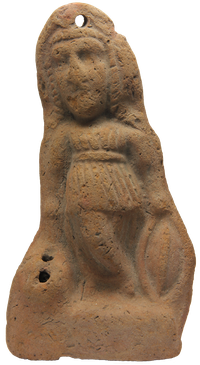Figurative Lamps in Roman Egypt
 |
The production of portable clay lamps, adopted from the Near East, did not initially differ in Egypt from that of the other Mediterranean countries, where bowl, round-shoulder and discus lamps were produced[1]. In addition to ornaments, figures from Greek mythology were also reproduced on matrix lamps. Since the founding of Naukratis, the first Greek colony, but especially since the conquest of Egypt by Alexander the Great, there had been alignments between Greek and Egyptian deities[2].
After the Battle of Actium, in which Mark Antony, together with the last Ptolemaic ruler, Cleopatra VII, was defeated by the later Augustus, the Roman Empire extended its rule to Egypt. With the beginning of the Roman Empire, the production of terracotta lamps reached its peak. Portable lamps, which were probably derived from toreutics[3], light houses[4], busts[5] and head lamps[6] were produced. A speciality were the so-called frog lamps[7], as well as the miniature lamps integrated into architectures, sculptural figures and groups[8]. They are decorated with human figures, often with images of gods from the Egyptian-Greek-Roman pantheon[9], but no other deity is represented as often as Athena[10].
[1] A. Mlasowsky, Die antiken Tonlampen im Kestner-Museum (Hannover 1993) 16-21; C. Ewigleben – J. von Grumbkow (eds.), Götter, Gräber & Grotesken (Hamburg 1991) 36 f.
[2] Mlasowsky ibid. 20-51. 336-341; J. Fischer, Die Entwicklung der Götterfigur in der griechisch-römischen Koroplastik Ägyptens, in: Ägypten Griechenland Rom (Frankfurt am Main 2005) hier: 349 f.; Ewigleben ibid. 99 no. 138.
[3] Ewigleben ibid. 37. 100 no. 142; J. Griesbach (ed.), Griechisch ägyptisch. Tonfiguren vom Nil, Martin von Wagner Museum Würzburg (Regensburg 2013) 203 no. 82; J. Fischer, Griechisch-römische Terrakotten aus Ägypten (Tübingen 1994) 434 no. 1192 pl. 126; W. Schürmann, Katalog der antiken Terrakotten im Badischen Landesmuseum Karlsruhe (Göteborg 1989) 276 f. no. 1048 pl. 174; 278 no. 1053 pl. 175; 275 no. 1044 pl. 174; Mlasowsky ibid. 362 f. fig. 345; p. 364 f. figs. 349 and 347.
[4] E.g. Mlasowsky ibid. 360 f. no. 341. 342; Griesbach ibid. 189 no. 70.
[5] E. Bayer-Niemeier, Terrakotten in Ägypten, in id., Griechisch-römische Terrakotten. Sammlung Kaufmann I Liebieghaus (Melsungen 1988), 181-184 pld. 68-70; Ewigleben ibid. 32. 76 figs. 73. 75; Fischer ibid. 1994, 370-372 nos. 941. 942. 948. 949 pl. 99 f; Griesbach ibid. 207 fig. 86; Schürmann ibid. 275 f. no. 1045 pl. 174; LIMC II (1984) 1047 nos. 50-51 pl. 768 s. v. Athena in Ägypto (H. Cassimatis).
[6] Fischer ibid. 1994, 435 nos. 1195. 1196 pl. 126.
[7] Mlasowsky ibid. 368. 371 f. fig. 352-356; Ewigleben 101 no. 143.
[8] S. Sandri in: Ägypten Griechenland Rom (Frankfurt am Main 2005) 656 no. 247; Schürmann ibid. 276 no. 1047 pl. 174; Mlasowsky ibid. 418 f. no. 407; St. Schmidt, Katalog der ptolemaischen und kaiserzeitlichen Objekte aus Ägypten im Akademischen Kunstmuseum Bonn (München 1997) 79 f. no. 80 pl. 29.
[9] Fischer ibid. 1994, 327 no. 799 pls. 84 and 427 no. 1164 pl. 123; Schümann ibid. 278 no. 1053 pl. 175; Fischer ibid. nos. 684. 685 pl. 72; no. 1173 pl. 124; 324 no. 790 pls. 82 and 347 863 pl. 90; 430 no. 1175 Tpl. 124; Mlasowsky ibid. 362 f. fig. 345.
[10] Fischer ibid. no. 940-949 pl. 99 f. nos. 1177. 1180. 1189. 1190 pls. 124-126; Ewigleben ibid. 76 nos. 73-75; Schürmann ibid. nos. 1044-1048 pl. 174; LIMC II (1984) 1047 nos. 50-51 pl. 768 s. v. Athena in Ägypto (H. Cassimatis).
